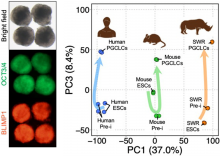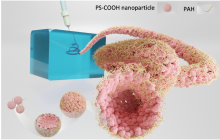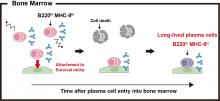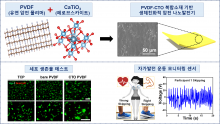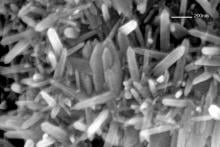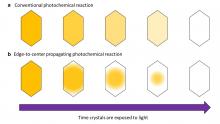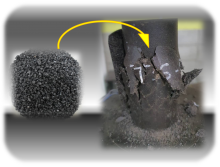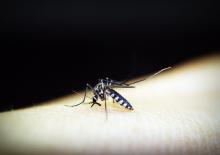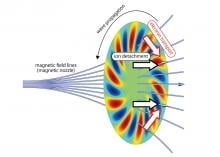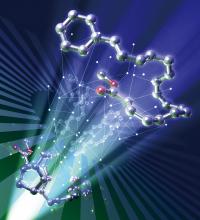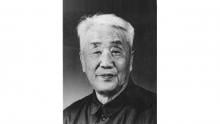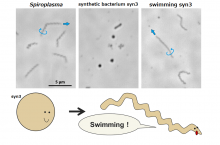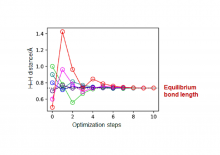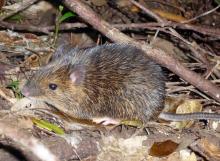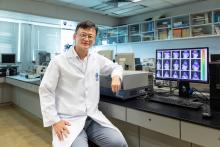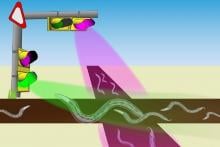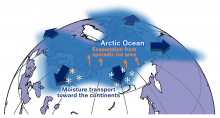Science
News
22 Dec 2022
A research team led by Osaka Metropolitan University has revealed a difference in neural activity in response to visual food stimuli, depending on whether those stimuli are presented consciously or unconsciously. Using a questionnaire to assess the study participants, the team found that this difference was associated with their scores on eating behaviors, including emotional eating and cognitive restraint of food intake. These results indicate that eating behavior cannot be understood without taking into account both unconscious and conscious neural processes.
22 Dec 2022
Osaka Metropolitan University scientists discovered the principle of light-induced acceleration of antigen–antibody reaction, allowing for simple, ultrafast, and highly sensitive detection of proteins. The researchers introduced target proteins and probe particles with modified antibodies selectively binding to the target proteins into a small channel and applied irradiation with infrared laser light. They achieved, for the first time, the rapid measurement of trace amounts of attogram-level target proteins after only 3 minutes of laser irradiation. These findings will potentially contribute to breakthroughs in the development of systems for ultra-early diagnosis of various diseases.
19 Dec 2022
When stars die out, they emit gamma-ray bursts. Although scientist can calculate the explosion energy from dying stars, it is difficult to do when the conversion efficiency is low or unknown. Using light polarization, a research group has found a workaround for this, enabling astronomers to calculate the hidden energy of gamma-ray bursts.
19 Dec 2022
Sound velocities of superhydrous phase B and the presence of water in the Earth’s mantle
19 Dec 2022
Researchers from Osaka University have developed a culture system using pluripotent cells from southern and northern white rhinos, which was refined to produce primordial germ cell-like cells (PGCLCs). These cells are the equivalent of primordial germ cells, the origin of eggs and sperm. The study marks an important first step in the potential production of northern white rhino gametes, which could be used in breeding programs, and is the first to induce PGCLCs in a wild animal.
16 Dec 2022
There is a small area on the electromagnetic spectrum occupied by terahertz waves, where conventional electronic devices struggle to operate. Still, engineering devices that can take advantage of terahertz waves are crucial for the development of future wireless technology such as 6G and 7G. Using a graphene transistor, a research team has successfully detected terahertz waves with a fast response and high sensitivity at room temperature.
15 Dec 2022
In baseball, even the smallest detail can tip the scales in favor of the batter or the pitcher. A recent publication has highlighted how rosin powder helps maintain a more constant friction when pitching, something that could bring about a fairer playing field in Major League Baseball.
15 Dec 2022
A research team led by the University of Hong Kong (HKU) and Lawrence Berkeley National Laboratory has invented an all-water robotic system that resolves the constraints of bio-inspired robots through revolutionary scientific advances.
15 Dec 2022
Understanding how bats tolerate viral infections, Material separates water from...water, The virtual sense of touch polished to next level and COVID-19 negatively impacted early-careers and female researchers. Read all in the December's Editor's Choice.
14 Dec 2022
Using cryogenic electron microscopy, a research team from the Research Center for Artificial Photosynthesis (ReCAP) at Osaka Metropolitan University has revealed, for the first time, the structures and binding environments of pigments bound to a protein called a photosynthetic antenna of the marine green macroalga Codium fragile. The team’s results extend our knowledge about the molecular mechanism by which blue-green light—the only light available in deep seawater—is efficiently utilized for photosynthesis.
14 Dec 2022
Researchers led by Osaka University generated a time-stamping method to trace the development and survival of plasma cells in the bone marrow and spleen. Using a mouse model in which plasma cells were fluorescently labeled in an inducible manner, they found that plasma cells were continuously replenished by new cells, a small portion of which differentiated into long-lived plasma cells (LLPCs). These findings may aid in the development of new vaccines that efficiently induce LLPCs.
14 Dec 2022
- DGIST Joint Team of Professors Kim Hoe-joon and Hong Seon-ki developed high-efficiency piezoelectric energy harvesting technology using materials harmless to humans
- Attachable to body, generates energy and diagnoses exercise posture... Published in the November issue of ‘Nano Energy’
13 Dec 2022
Researchers at The University of Tokyo develop a simple but effective method of bonding polymers with galvanized steel, a material ubiquitous in the automobile industry, to cheaply and easily create a lightweight and durable product.
13 Dec 2022
A research group at Osaka Metropolitan University has discovered that 2,5-distyrylpyrazine (DSP) crystals undergo a unique photoreaction. Normally, photoreactive color changes proceed uniformly throughout photomechanical molecular crystals, so that all parts of each crystal change color at the same time. However, when light shines evenly on a DSP crystal, the photoreaction propagates from edge to center, deviating from conventional photochemistry models. The group found that this phenomenon was caused by a surface effect and a cooperative effect, which make reactivity extremely high for molecules at the crystal’s edge and those adjacent to molecules that have already changed color.
12 Dec 2022
Revelations about the mechanisms of two key proteins which maintain the asymmetric distribution of cholesterol within the cell membrane could help understand and treat diseases linked to its imbalance
09 Dec 2022
Scientists from Universiti Teknologi Malaysia have reported a novel way to produce reinforced concrete materials using tin slag aggregates, which is a by-product of the smelting process. This way of producing concrete enables tin slag to become a useful material, as well as reducing the amount of natural resources used, which in turn contribute to reducing carbon footprint in the construction industry.
09 Dec 2022
− The European Commission Approved QDENGA (TAK-003) for Use in Individuals Four Years of Age and Older [i]
− QDENGA Becomes the Only Dengue Vaccine Approved in the EU for Use in Individuals Regardless of Previous Dengue Exposure [i]
07 Dec 2022
Magnetic nozzle plasma thrusters are thought of as the future of space travel. But one problem has hampered their development – plasma detachment. A recent study has shown that spontaneously excited plasma waves help magnetic nozzles overcome the plasma detachment problem, a rare instance of plasma instabilities having a positive effect on engineering.
06 Dec 2022
World's first research into relationship between rich-in-biodiversity garden greenery and health/well-being launched by University of Tokyo and Sekisui House Ltd.
01 Dec 2022
Automated reaction path search method predicts accurate stereochemistry of pericyclic reactions using only target molecule structure.
01 Dec 2022
Giants in History: Chinese palaeontologist, archaeologist and anthropologist Pei Wenzhong (January 19, 1904 – September 18, 1982) is regarded as a founder of Chinese anthropology.
30 Nov 2022
Osaka Metropolitan University researchers introduced seven proteins, thought to let bacteria swim by switching the direction that their helical bodies spiral, into a strain of synthetic bacterium with minimal genetic information. As a result, they confirmed that the synthetic bacterium named syn3, which is normally spherical, formed a helix that could swim by spiraling. Further investigation revealed that only two of these newly added proteins were required to make syn3 capable of minimal swimming. This swimming synthetic bacterium can be said to be the smallest mobile lifeform genetically, as it contains the fewest number of genes.
29 Nov 2022
Using a quantum computer, Osaka Metropolitan University researchers utilized quantum logic circuits to directly calculate, in a single calculation, the energy difference between two molecular geometries. The developed method was then applied to execute the molecular geometry optimization of typical molecular systems. On a classical computer, calculations based on the finite difference method require at least two evaluations of the energy for one-dimensional systems, but previous research has shown that a quantum computer can be used to calculate the energy derivatives based on this method in a single calculation. However, quantum circuits relevant to quantum algorithms capable of performing the energy derivative calculations had not been implemented. The research group has successfully created a quantum circuit to calculate the energy derivatives by modifying the quantum circuit used in the previously developed quantum phase difference estimation algorithm.
28 Nov 2022
The Sox9 gene is upregulated in the absence of sex-determining Y chromosome and Sry gene in Amami spiny rat.
28 Nov 2022
A Hong Kong Baptist University (HKBU) collaborative research team has synthesised a nanoparticle named TRZD that can perform the dual function of diagnosing and treating glioma in the brain. It emits persistent luminescence for the diagnostic imaging of glioma tissues in vivo and inhibits the growth of tumour cells by aiding the targeted delivery of chemotherapy drugs. The nanoparticle offers hope for the early diagnosis and treatment of glioma, especially cerebellar glioma, which is even harder to detect and cure with existing methods.
28 Nov 2022
We don’t know much about the Earth’s inner core because recreating its conditions in a laboratory setting remains fraught with difficulties. Based on tracking seismic waves, scientists theorize that the area in and around the core comprises mostly of iron. But the values extracted from these indicators differ from how pure iron typically behaves. Now, a collaborative research group has succeeded, for the first time, in measuring the speed of sound of pure iron under pressures similar to the Earth’s inner core boundary.
25 Nov 2022
A research group at the Osaka Metropolitan University Graduate School of Science has revealed a new system that allows them to control the behavior of the nematode worm Caenorhabditis elegans, using two different animal opsins, a type of light-sensitive protein. The first opsin was expressed in the worms’ sensory cells responsible for triggering avoidance behavior, making the worms move. This opsin was found to be approximately 7,000 times more sensitive to white light than the commonly used optogenetic protein channelrhodopsin-2. Likewise, a UV-sensitive opsin was expressed in the worms’ motor neurons, causing the worms to stop when exposed to UV light and start moving again when exposed to green light. Both opsins tested can be switched on and off repeatedly without breaking down, making them robust tools for future research, including the field of drug discovery.
24 Nov 2022
A new model explains that water evaporating from the Arctic Ocean due to a warming climate is transported south and can lead to increased snowfall in northern Eurasia in late autumn and early winter. This information will allow for more accurate predictions of severe weather events.

23 Nov 2022
Professor Chua Chee Kai and Associate Professor Yuen Chau, from the Engineering Product Development pillar at SUTD join the list of Highly Cited Researchers™ (HCR) 2022.
21 Nov 2022
Theory-guided development of an easier, more versatile process for synthesizing unsymmetric ligands provides new avenues of exploration in transitional metal catalysis.
Events

16 May 2011
For the seventh year in a row, global senior researchers, industry leaders and policy makers will gather at the International Nanotechnology Conference on Communication and Cooperation.

06 Dec 2011
The much awaited environment and wildlife biennial international competitive film festival and forum, CMS VATAVARAN is back. Film entries are invited from Indian and International filmmakers for 2011 festival focusing on biodiversity conservation.
10 Mar 2011
The Hong Kong Polytechnic University (PolyU) will host the fifth International Functional Food Symposium, which is themed on “Promoting Good Health and Developing a Sustainable Environment”, on its campus from 10 to 11 March 2011.

01 Jun 2011
SUMMER 2011: BIODIESELCOURSES Level 1, 2 & 3 "providing a great opportunity to those students who have passion for renewable energy and looking for a great future in global biodiesel industry."
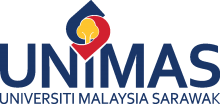
13 Sep 2011
The 2nd SWS Asia Chapter's 2011 Asian Wetland Convention and Workshop which will be held in Kuching, the capital city of Sarawak for the first time in September 13-15, 2011.

28 Sep 2011
The 9th Malaysia Genetics Congress themed “Appreciating the richness of nature through genetics” will be held from 28th to 30th September 2011 at Pullman Hotel, Kuching, Sarawak, Malaysia.

22 Jun 2011
The Faculty of Information Management, Universiti Teknologi MARA, Shah Alam, Malaysia, is hosting A-LIEP 2011: Asia-Pacific Conference on Library & Information Education and Practice- Issues, Challenges and Opportunities on 22-24 June 2011.

20 Nov 2011
TACT 2011 is to provide an open forum to discuss the current status of the scientific and technological achievements in coatings and thin films that are of great importance and interest to academic and industry.

28 Sep 2011
The 2011 International Conference on Solid Sate Devices and Materials (SSDM2011) will be held from September 28 on Wednesday, through 30 on Friday at The Aichi Industry & Labor Center (WINC AICHI), Nagoya, Japan.

08 Sep 2011
This conference provides an opportunity for the presentation and
discussion of the latest advances in modeling and simulation of
semiconductor devices, processes, and equipments for integrated circuits.

22 May 2011
The objective of this conference is to provide a platform for scientists and engineers to share their experience and knowledge on high temperature materials and structures, in order to explore new materials and their new applications.

13 Apr 2011
Photomask Japan 2011 is the 18th international symposium on photomasks and NGL masks in Japan. The aim of the symposium is to bring together engineers and investigators from Japan, USA, and all over the world in the field of photomasks, NGL masks, and related technologies to discuss recent progress, applications, and future trends.

14 Mar 2011
TOEO-7 follows preceding TOEO symposia and will be held at International Conference Center, Waseda University, Tokyo, Japan (Japanese Web). TOEO-7 will come with more than 20 highly-reputed Invited Speakers.

16 Feb 2011
'nano tech' International Nanotechnology Exhibition & Conference is the world’s largest nanotechnology fair and an essential event for state-of the-art manufacturing.
18 Feb 2011
In the present symposium, cutting-edge nanotechnology R&Ds related to energy, environment, and resources issues are presented.

14 Sep 2011
The Centre for Jatropha Promotion & Biodiesel is set to hold 4th Global Jatropha Hi-tech Integrated Nonfood Biodiesel Farming & Technology Training Programme. The training program will cover sustainable business models, R&D progress and application technologies, including the introduction of new potential nonfood biodiesel crops.

19 May 2011
The International Center for Science, Technology, and Art, University of Sumatera Utara (IC-STAR USU), Medan - Indonesia is going to hold the 7th International Conference on Numerical Analysis in Engineering (NAE2011) on May 19th - 20th, 2011 in Manado, North Sulawesi - Indonesia.

25 Apr 2011
BIT’s 2nd Inaugural Symposium on Enzymes & Biocatalysis-2011 (SEB-2011) will be held during April 25-29, 2011, Dalian, China.

19 Apr 2011
Chemistry conference covering all aspects of chemistry.

10 Apr 2011
The 1st International Conference on Clean Energy will be held on the 10th-13th April in Dalian, China.

07 May 2011
The aim of the ICFEB conference series is to provide a forum for laying the foundations of a new principled approach to Food Engineering and Biotechnology.

28 Nov 2011
BIOCICON 2011 is aimed to promote basic and applied research and development for ecofriendly pest disease and nematode management in agriculture, horticulture and forestry.

27 Apr 2011
The International Workshop on the Advances in Computational Methods for Fluid Structure Interaction is the first international conference/workshop to be held in Asia Pacific.

03 Feb 2011
The first international symposium of the Strategic Exploitation of Neuro-Genetics for Emergence of the Mind program is to be held on 3 February 2011 in Tokyo, Japan.

06 Jul 2011
International Symposium on Sputtering and Plasma Processes (ISSP) was established in 1991. The symposium to be held in 2011 will take place in Kyoto.

14 Jun 2011
The 2011 Symposium on VLSI Technology and the 2011 Symposium on VLSI Circuits will be held on June 14-16 and June 15-17, 2011 respectively.

08 Mar 2011
The 1st International Symposium on Advanced Nanostructured Materials for Clean Energy (ANMCE, 2011) will be held during March 8-10, 2011 in Osaka, Japan.
02 Mar 2011
The MANA International Symposium, jointly held with International Center for Young Scientist (ICYS) is organized once a year to publish the research activities of MANA and ICYS.
Giants in history
Chinese biochemist Chi Che Wang (1894 - 1979), one of the first Chinese women to study abroad, advanced to prominent research positions at American institutions including the University of Chicago and the Northwestern University Medical School.
Ruby Sakae Hirose (1904 – 1960) was a Japanese-American scientist whose research contributed significantly to our understanding of blood clotting, allergies and cancer.
Chinese electron microscopy specialist Li Fanghua (6 January 1932 – 24 January 2020) facilitated the high-resolution imaging of crystal structures by eliminating interference.
Sálim Moizuddin Abdul Ali (12 November 1896 – 20 June 1987), commonly referred to as the Birdman of India, was the first person to conduct systematic surveys of birds from across India.
Haisako Koyama (1916 – 1997) was a Japanese solar observer whose dedication to recording sunspots – cooler parts of the sun’s surface that appear dark – produced a sunspot record of historic importance.
Michiaki Takahashi (17 February 1928 – 16 December 2013) was a Japanese virologist who developed the first chickenpox vaccine.
Toshiko Yuasa (11 December 1909 – 1 February 1980) was the first Japanese female physicist whose research on radioactivity shed light on beta decay – the process in which an atom emits a beta particle (electron) and turns into a different element.
Angelita Castro Kelly (1942-2015) was the first female Mission Operations Manager (MOM) of NASA. She spearheaded and supervised the Earth Observing System missions during its developmental stage.
Malaysia’s first astrophysicist, Mazlan binti Othman (born 11 December 1951) was instrumental in launching the country’s first microsatellite, and in sending Malaysia’s first astronaut, Sheikh Muszaphar Shukor, into space.
Known as Mr. Natural Rubber, chemist and researcher B. C. Shekhar (17 November 1929 – 6 September 2006) introduced a number of technical innovations that helped put Malaysia’s natural rubber industry on the world map.
Shinichiro Tomonaga (31 March 1906 – 8 July 1979), together with Richard Feynman and Julian Schwinger, was awarded the Nobel Prize in Physics in 1965, for their contributions to advance the field of quantum electrodynamics. Tomonaga was also a strong proponent of peace, who actively campaigned against the proliferation of nuclear weapons and promoted the peaceful use of nuclear energy.
South Korean theoretical physicist Daniel Chonghan Hong (3 March 1956 – 6 July 2002) achieved fame in the public sphere through his research into the physics of popcorn.
Japanese chemist Kenichi Fukui (4 October 1918 – 9 January 1998) was the first Asian scientist to be awarded the Nobel Prize in Chemistry. Together with Roald Hoffman, he received this honour in 1981 for his independent research into the mechanisms of chemical reactions.
Chinese palaeontologist, archaeologist and anthropologist Pei Wenzhong (January 19, 1904 – September 18, 1982) is regarded as a founder of Chinese anthropology.
Physicist Narinder Singh Kapany (31 October 1926 – 4 December 2020) pioneered the use of optical fibres to transmit images, and founded several optical technology companies. Born in Punjab, India, he worked at a local optical instruments factory before moving to London for PhD studies at Imperial College. There, he devised a flexible fibrescope to convey images along bundles of glass fibres.
Japanese physicist Ukichiro Nakaya (1900-1962) made the world’s first artificial snowflakes. He started his research on snow crystals in the early 1930s at Hokkaido University, where there is an unlimited supply of natural snow in winter. By taking over 3,000 photographs, he established a classification of natural snow crystals and described their relationship with weather conditions.
The field of solid-state ionics originated in Europe, but Takehiko Takahashi of Nagoya University in Japan was the first to coin the term ‘solid ionics’ in 1967. ‘Solid-state ionics’ first appeared in 1971 in another of his papers, and was likely a play on ‘solid-state electronics’, another rapidly growing field at the time.
Charles Kuen Kao (Nov. 4, 1933 to Sept. 23, 2018) was an engineer who is regarded as the father of fibre optics. His work in the 1960s on long distance signal transmission using very pure glass fibres revolutionized telecommunications, enabling innovations such as the Internet.
Chika Kuroda (24 March 1884 – 8 November 1968) was a Japanese chemist whose research focussed on the structures of natural pigments.
Motoo Kimura (13 November 1924 – 13 November 1994) was a Japanese theoretical population geneticist who is best remembered for developing the neutral theory of molecular evolution.
Meghnad Saha (6 October 1893 – 16 February 1956) was an Indian astrophysicist best known for formulating the Saha ionization equation which describes the chemical and physical properties of stars.
Sir Jagadish Chandra Bose (30 November 1858 – 23 November 1937) was a scientist and inventor who contributed to a wide range of scientific fields such as physics, botany and biology.
Osamu Shimomura (27 August 1928 – 19 October 2018) was a Japanese organic chemist and marine biologist who dedicated his career to understanding how organisms emitted light.
Subrahmanyan Chandrasekhar (19 October 1910 – 21 August 1995) was an Indian astrophysicist who studied the structure and evolution of stars.
Joo-myung Seok (November 13, 1908 – October 6, 1950) was a Korean butterfly entomologist who made important contributions to the taxonomy of the native butterfly species in Korea.
Mathematician Maryam Mirzakhani (12 May 1977 – 14 July 2017) was the first and only woman and Iranian to date to win the Fields Medal in 2014 for her work on curved surfaces.
Sir Chandrasekhara Venkata Raman (7 November 1888 – 21 November 1970) was an Indian physicist who performed ground-breaking research in the field of light-scattering.
Mohammad Abdus Salam (29 January 1926 – 21 November 1996) was a theoretical physicist and the first Pakistani to receive a Nobel Prize in science.
Srinivasa Ramanujan (22 December 1887 – 26 April 1920) was a math prodigy and widely considered one of India’s greatest mathematicians. Despite having almost no formal training in mathematics, he made substantial contributions to mathematical analysis, number theory, infinite series and continued fractions.
Gopalasamudram Narayanan Ramachandran (8 October 1922 – 7 April 2001) is best known for developing the Ramachandran plot to understand the structure of short chains of amino acids, known as peptides.
Hitoshi Kihara (1893 – 1986) was one of the most famous Japanese geneticists of the 20th century. One of his most significant contributions was identifying sex chromosomes (X and Y) in flowering plants.
Chien-Shiung Wu (31 May 1912 – 16 February 1997) was an experimental physicist who made several important contributions to nuclear physics. Wu worked on the Manhattan Project – a top-secret program for the production of nuclear weapons during World War II and helped to develop a process for separating uranium into U235 and U238.
Meemann Chang (born 17 April 1936) is a Chinese palaeontologist who studied the fossils of ancient fish to understand the evolution of life. By examining fossils, she uncovered new insights on how vertebrates, animals with a backbone, migrated from the sea and became adapted to live on land.
Bibha Chowdhuri (1913 – 2 June 1991) was an Indian physicist who researched on particle physics and cosmic rays. In 1936, she was the only female to complete a M.Sc. degree at the University of Calcutta.
Lin Lanying (7 February 1918 – 4 March 2003) was a Chinese material engineer remembered for her contributions to the field of semiconductor and aerospace materials. Lanying was born into a family who did not believe in educating girls and she was not allowed to go to school.
Japanese geochemist Katsuko Saruhashi developed the first method and tools for measuring carbon dioxide in seawater






